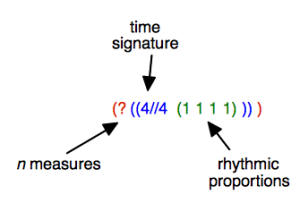| Navigation : Previous | Next |
Rhythm Trees Structure
Traditionally, rhythm is broken up into several data : meter, measure(s) and duration(s). Rhythm trees must enclose these information in lists and sublists.
This elementary rhythm :
![]()
can be expressed as follows :
- ( ? ( (4//4 (1 1 1 1) ) ) )
- ( ? ( ( (4 4) (1 1 1 1) ) ) )
A tree structure can be reduced to a list : (D (S)).
Main Components : Duration and Subdivisions
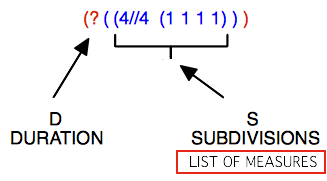
- D = a duration , or number of measures : ( ? ) or a number ( n ).
When D = ?, OM calculates the duration.
By default, this duration is equal to 1.
-
S = subdivisions (S) of this duration, that is a time signature and rhythmic proportions.
- Time signature = n // n or ( n n ).
It must be specified at each new measure, even if it remains unchanged.
2. Rhythm = proportions : ( n n n n )
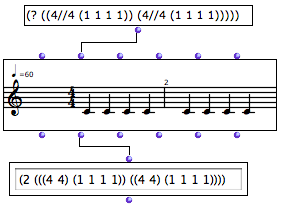
Here, the (1 1 1 1) sub list represents four equal subdivisions of a 4/4 measure. OM calculated that the tree has two measures.
Parenthesis Levels
A rhythm tree has at least three levels of parenthesis :
-
number of measures
-
list of measures
-
time signature and proportions.
Note that different rhythm trees with equal proportional structures produce the same rhythmic result :
( 1 1 1 1) = (2 2 2 2) = (124 124 124 124)
Durations
Manipulating Durations
By default, the duration of a measure is equal to 1. 1 represents the global measurement unit traditionally expressed by the time signature, such as : 4/4, 2/2 = ![]() , 3/8 =
, 3/8 = ![]() etc.
etc.
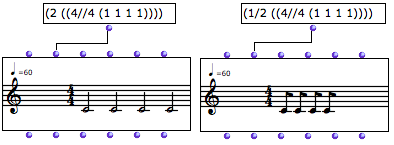
Changing this value multiplies or divides all the durations by a given coefficient.
Subdivisions : Measures and Groups
Measures
Trees define the way ** measures ** are split into proportional durations.
The following rhythm :
![]()
is written : ( ? ( (4//4 (1 2 1) ) ) **)** .
Groups
Trees also define internal subdivisions, or ** groups[1] ** , within a measure .
The following rhythm :
![]()
is written : ( ? ( (4//4 (1 ( 2 (1 1 1) ) 1) ) ) **** )** .
Writing Groups
Note that groups must be written with a new subordinate level of parenthesis.
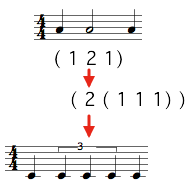
References :
- [1] Group
An internal subdivision, that is, a list of proportions within a measure. A group can enclose a sub group. Basic examples are tuplets, groups of eighth, sixteenth notes. Groups of quarter, semibreves, whole notes or any other values are also admitted in rhythm trees.
For instance :
(? ((4//4 ( (2 ( 1 1)) (1 ( 1 (1 (1 1 1)))) (1 (1 1 1 1 1)) )))).
This one measure tree has one group - two quarter notes - , one group with a sub group - one eighth note and a sixteenth notes triplet, and a last group - a quintuplet.
![]()
Contents :
- OpenMusic Documentation
- OM User Manual
- OpenMusic QuickStart
| Navigation : Previous | Next |
